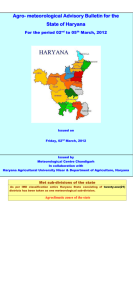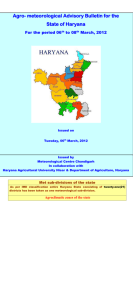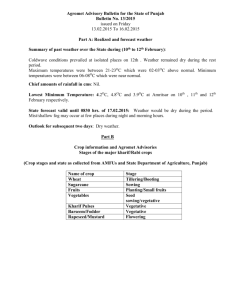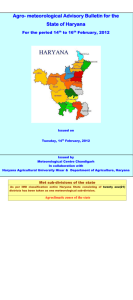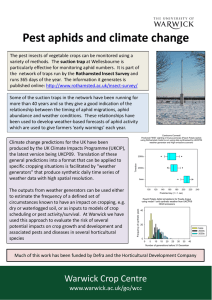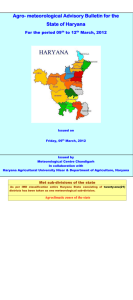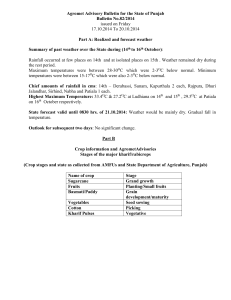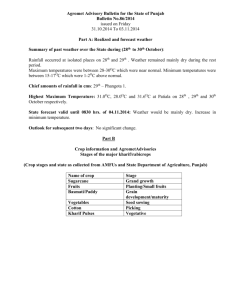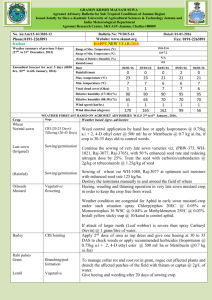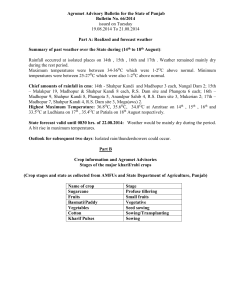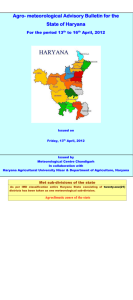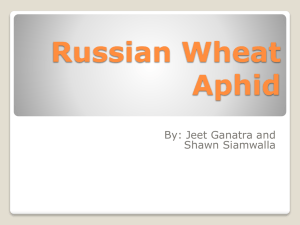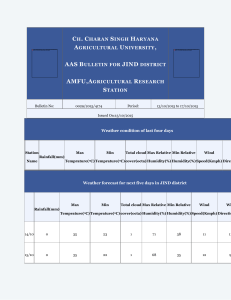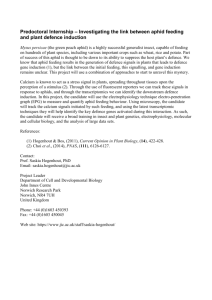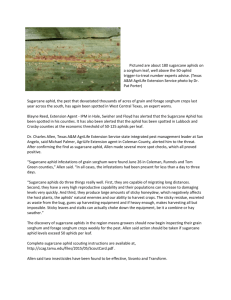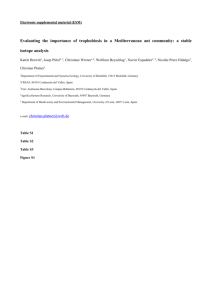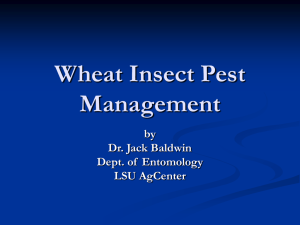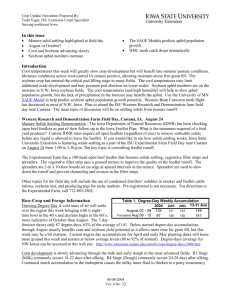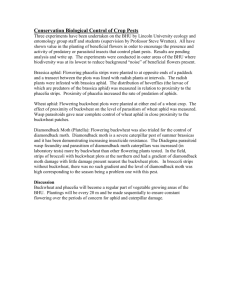Issued on
advertisement
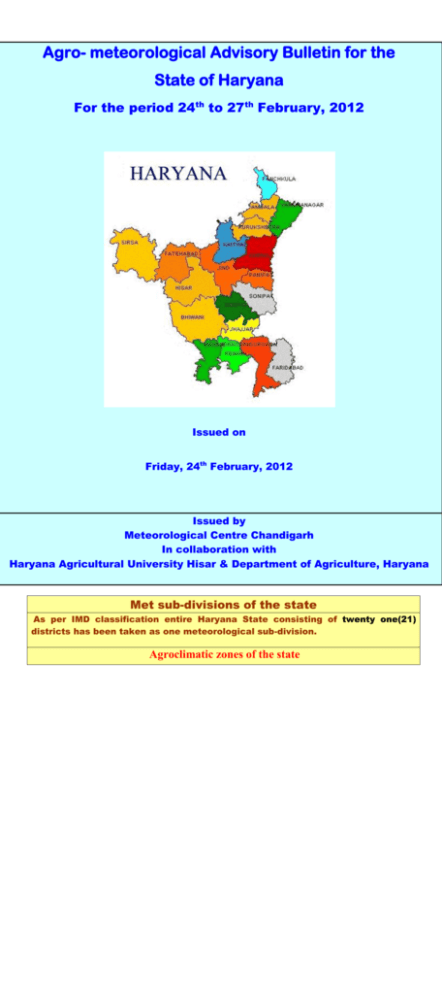
Agro- meteorological Advisory Bulletin for the State of Haryana For the period 24th to 27th February, 2012 Issued on Friday, 24th February, 2012 Issued by Meteorological Centre Chandigarh In collaboration with Haryana Agricultural University Hisar & Department of Agriculture, Haryana Met sub-divisions of the state As per IMD classification entire Haryana State consisting of twenty one(21) districts has been taken as one meteorological sub-division. Agroclimatic zones of the state No. 2 Agroclimatic Zone Districts Agromet Field Unit (AMFU) Location Eastern zone Panchkula, Ambala, Faridabad, Kurukshetra, Karnal, Kaithal, Yamunanagar, Panipat, Sonepat & Parts of Jind, Rohtak, Jhajjar, Gurgaon and Mewat. Kaul (Kaithal) Western zone Sirsa, Fatehbad, Hisar, Bhiwani, Narnaul, Mahendergarh, Rewari, Parts of Jind, Rohtak , Jhajjar, Gurgaon and Mewat. Hisar Part I: Weather Significant Past Weather in different agroclimatic zones Weather Forecast for different agro-climatic zones For the period 21/02/2012 to 23/02/2012. valid until 0830 hrs of 28/02/2012 (Area Covered in 50 Km radius around the station) Eastern zone Rainfall occurred at isolated places on 21st . Weather will be mainly dry during the period. Cloudy Weather remained mainly dry during the rest weather likely afterwards. Rise in night temperature period. likely. Chief amounts of rainfall in cms: Nil. Mean maximum temperature was around 250 C Outlook for subsequent two days : No large change. which was 1-2 deg. C above normal. Mean minimum temperature was around 12 deg. C which was 2-3 deg. C above normal. The average morning and afternoon relative humidity were 75 and 40 percent respectively. The average wind speed during the period was 03 km/hr. Western zone st Rainfall occurred at isolated places on 21 . Weather will be mainly dry during the period. Cloudy Weather remained mainly dry during the rest weather likely afterwards. Rise in night temperature period. likely. Chief amounts of rainfall in cms: Nil. Mean maximum temperature was around 250C Outlook for subsequent two days : No large change. which was near normal. Mean minimum temperature was around 10 deg. C which was also near normal. The average morning and afternoon relative humidity were 80 and 45 percent respectively. The average wind speed during the period was 03 km/hr. Part II: Agroclimatic Zonewise Agricultural/Agro-meteorological Advisories Eastern zone Wheat Apply need based irrigation to the crop. Observe the wheat fields for appearance of yellow rust. As soon as the disease appears, spray the crop with Tilt @ 200ml in 200 litres of water per acre. Barley Spraying for aphid control to use the recommended chemical. Sugarcane Start sowing sugarcane and use recommended varieties. The sets selected for planting should be free from diseases like red rot, wilt, ratoon-stunting and grassy shoot. Disinfect cane sets in 0.5 per cent (500 g in 100 litres of water) Agallol 3 % or 0.25 per cent (250 g in 100 litres of water) solution of Emisan 6 %. Animal husbandry Cracks/sore/chapped/injured teats should be treated with teat tips (Glycerin : Providine Iodine 1:4). It should be used after every milking. Newly born calves need special care in cold weather, since they are susceptible to pneumonia and a large number of them die of this disease. Keep your animals under roof in night and in the sun during the day time. Do not feed green, sprouted, soiled or rotton potatoes to dairy animals. Theses can cause serious and fatal poisoning. Provide proper temperature under the brooder i.e. 95 ºF every week up to 70 ºF. Provide balanced feed and fresh water. Provide balanced ration to the birds according to their requirements. Deworm the chicks regularly. Keep watch for development of aphid on vegetables as temperature is increasing and apply recommended spray. As no rain is expected, one can go for sowing of arbi and turmeric. Vegetables & Fruits Oil Seeds Pulses Malathion 50EC @2.0-3.0g/lit of water may be sprayed to control aphid. Monitor the crop for the attack of insect pests. The problem of helicoverpa in gram, if any, may be controlled with the help of recommended pesticides. Use sevin/hexasevin 50 WP in lentil for the control of pod borer. Western zone Wheat Apply need based irrigation to the crop. Observe the wheat fields for appearance of yellow rust. As soon as the disease appears, spray the crop with Tilt @ 200ml in 200 litres of water per acre. Barley Vegetables & Fruits Sugarcane Spraying for aphid control to use the recommended chemical. Keep watch for development of aphid on vegetables as temperature is increasing and apply recommended spray. As no rain is expected, one can go for sowing of arbi and turmeric. Animal Husbandry Cracks/sore/chapped/injured teats should be treated with teat tips (Glycerin : Providine Iodine 1:4). It should be used after every milking. Newly born calves need special care in cold weather, since they are susceptible to pneumonia and a large number of them die of this disease. Keep your animals under roof in night and in the sun during the day time. Do no feed green, sprouted, soiled or rotton potatoes to dairy animals. Theses can cause serious and fatal poisoning. Provide proper temperature under the brooder i.e. 95 ºF every week up to 70 ºF. Provide balanced feed and fresh water. Provide balanced ration to the birds according to their requirements. Deworm the chicks regularly. Oil Seeds Malathion 50EC @2.0-3.0g/lit of water may be sprayed to control aphid. Pulses Monitor the crop for the attack of insect pests. The problem of helicoverpa in gram, if any, may be controlled with the help of recommended pesticides. Use sevin/hexasevin 50 WP in lentil for the control of pod borer. Start sowing sugarcane and use recommended varieties. The sets selected for planting should be free from diseases like red rot, wilt, ratoon-stunting and grassy shoot. Disinfect cane sets in 0.5 per cent (500 g in 100 litres of water) Agallol 3 % or 0.25 per cent (250 g in 100 litres of water) solution of Emisan 6 %.
